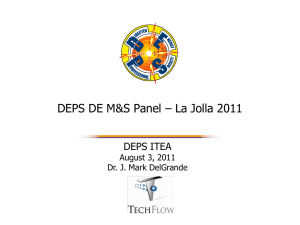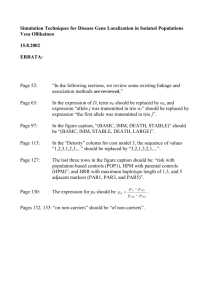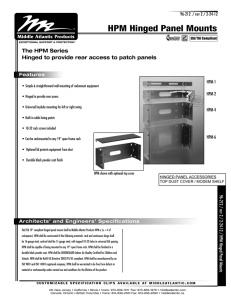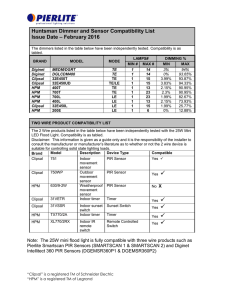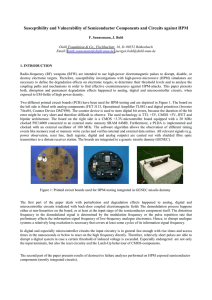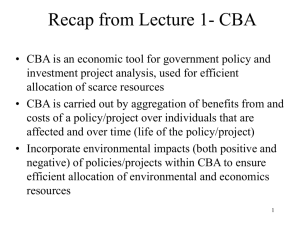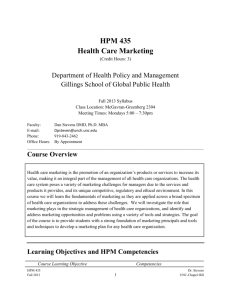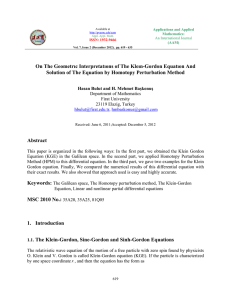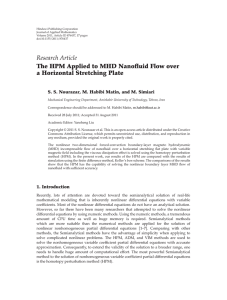Rodgers_HPM_Effects - TerpConnect
advertisement
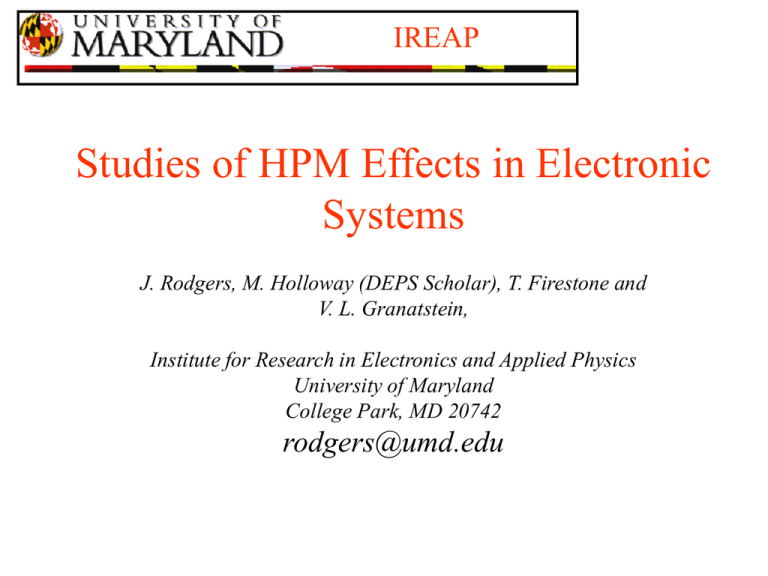
IREAP Studies of HPM Effects in Electronic Systems J. Rodgers, M. Holloway (DEPS Scholar), T. Firestone and V. L. Granatstein, Institute for Research in Electronics and Applied Physics University of Maryland College Park, MD 20742 rodgers@umd.edu IREAP Outline • The basic electronics of HPM effects • Summary of 2008 work – Began testing of mixed-signal systems – Studied HPM susceptibility of sensors (ARL) – Development of systems modeling capability • Wideband multi-frequency test source (AFOSR-Plasma Physics) • Proposed 2009 Effort IREAP Scope of Work EM Coupling Cavity Fields Validate Test Circuit Response HPM Source HPM Effects Models IREAP Large-signal (LS) Semiconductor Electronics NL QM Input Pad Cross section of a planar semiconductor Typical LS currentvoltage characteristics IREAP Semiconductor junctions + package/trace reactance Nonlinear resonances NL Frequency products HPM 10 Amplitude Amplitude 10 0 0 0 2000 Frequency 0 2000 Frequency Both frequency bands can produce effects. HPM-driven instability in circuits Typical RF Voltage @ IC Input Circuit Response 4 5 3 4 Voltage Voltage 5 2 3 2 1 1 0 0 0 10 20 Time (msec) 30 0 5 10 Time (msec) 15 20 The Effects “Spectrum” RF-to-BB Voltage Transfer 2.5 0.13 Micron Processor High-speed_CMOS CD 4000 2 1.5 1 0.5 0 0 Magnitude 1000 2000 vs. Frequency 3000 of Input Impedance and Bias Voltage(MHz) Frequency 1000 8 6 Impedance [Ohms] Quality Factor 4000 4 2 100 Vbias= -0.70 Vbias= -0.60 Vbias= -0.50 10 Vbias= -0.40 0 Vbias= 0.0 0.0 0.5 1.0 1.5 2.0 2.5 Resonant Frequency (GHz) 3.0 3.5 Vbias= +2.0 1 0 0.5 1 Frequency [GHz] 1.5 2 IREAP •IR PIN Photo Detector Effect (V / kW*m^2) HPM Effects in Sensors & Detectors Applications: Communications, Imaging, Ranging, Detection, Encoding 600 400 200 0 1 1.1 1.2 1.3 1.4 1.5 •Hall Effect Sensor Effect (V / kW*m^2) Frequency (GHz) 100 80 60 40 20 0 1 1.1 1.2 1.3 Frequency (GHz) 1.4 1.5 Soft effects could be fatal to a system 3.5 2 1.5 1 2.5 2 4 1.5 2 1 Gain 0 0.5 0.5 RF Out 0 0 0.2 0.4 0.6 0.8 RF Amplitude (V) Over-Current: PMOS and NMOS conduct at the same time! 1 -2 0 0 0.2 0.4 0.6 0.8 RF Amplitude (V) Cascaded Gain Effects 1 Output RF (V) Vout (V) Ids (mA) 2.5 6 RF Gain (dBv) 3-10 times normal current 3 IREAP HPM “Over-Current” Effect in CMOS 500 PMOS Ids Ids (mA) 400 1500 MHz Vg 300 800 MHz 200 NMOS DC 400 MHz 100 100 MHz 0 0 0.5 1 V g (V) 1.5 2 IREAP Can existing codes (e.g. Agilent ADS) be used to model HPM effects? IREAP RF Model Libraries for Standard IC Packages HPM IREAP The EM characteristics of electrically small (d<l) features (IC packaging leads, bonding wires, etc.) can be extracted and modeled as lumped elements. IREAP Parasitic elements are then coupled to nonlinear circuit models Bond wire and package model Nonlinear IC model Models agree well at the device level. 400 CMOS ESD Ids (m A) 300 200 Comparison of measured & simulated over-current effect in AMI 0.5m CMOS 100 0 0 1 2 V g (V) •Model parameters extracted from process technology files. •Some modification required to account for NQS and HF device operation. •Use nonlinear device and harmonic balance simulation mode (s>3). 3 IREAP AGILENT ADS Design Flow HPM IREAP Development of Novel Wideband HPM Test Sources High-power Output Directional Coupler Traveling-wave Device Plasma E-Beam Dynamic Control Delay Line Variable Atten. High-Current Plasma Cathode High-Power RF Coupler IREAP HPM source with chirp-hop output frequency Loop Gain = 15 dB Time (ms) Time (ms) Loop Gain = 5 dB Sw Frequency (MHz / 10) Sw Frequency (MHz / 10) IREAP Collaborations • NSWC to conduct effects tests on vehicles using UMD source. • ARL: performing basic effects tests on various sensors (e.g. IR) of interest. • AFRL: EMERD • NRL • Sandia: new basic research program in progress. IREAP Research Personnel • PhD: – Todd Firestone, graduated December 2008 – Mike Holloway, DEPS Scholarship, projected to graduate fall 2009 • Postdoctoral: – Dr. Zeynep Dilli: QM device physics and modeling, joined group Jan. 2009 • Undergraduates: – Collin Kennedy & Mark Strother (juniors physics)
